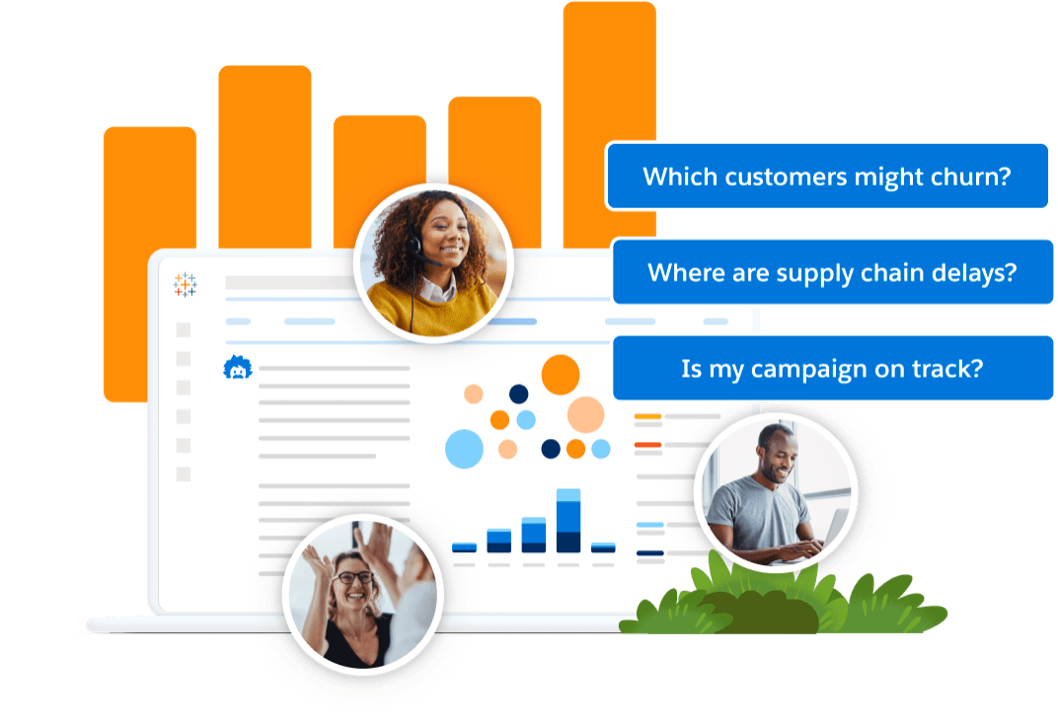
Tableau Pulse: empowering business users

Learn how Tableau’s integrated suite of predictive and generative AI capabilities powers trusted insights across your organization.
What is Tableau AI?
- Tableau AI is a fully integrated, next-generation portfolio of AI-plus-analytics capabilities that enables everyone in an organization to drive tangible business outcomes. It is trusted AI across the entire Tableau platform, simplifying and democratizing data analysis and insight consumption at scale.
- Tableau AI leverages the advanced capabilities of generative AI (GAI): a subset of AI technologies that enables machines to understand patterns, learn from data, and create something entirely new. In other words, generative AI processes user input to generate meaningful content on its own.
Tableau AI provides every business user with smart, personalized, and contextual insights right in their flow of work. Tableau AI accelerates time to insights and reduces repetitive tasks for data analysts with intelligent suggestions and in-product guidance—all based on a trusted foundation.
Tableau Pulse: empowering business users
The majority of end consumers of analytics are business users and leaders whose primary job is not data analysis. They’re efficient in their workflows and want data to add to that efficiency. They also have limited bandwidth for finding answers to the business questions tied to their jobs.
This is what Tableau Pulse aims to do—proactively deliver personalized, smart, and contextual Insights for Metrics to business users in their flow of work, answering the “what”, “why”, and “so what” of the data most relevant to their job and business.
How does Tableau AI power Tableau Pulse?
While AI does not solve all the problems business users face, it can significantly enhance and accelerate their ability to consume metrics. AI infused throughout Tableau Pulse personalizes their experience to maximize the proactive delivery of timely insights.
The first place generative AI appears in Tableau Pulse is Insight Summaries. This is where the large language model (LLM) looks at key insights detected across the metrics a user follows to create a natural language overview of those metrics’ performance across the board. This is available at the top of the user's Tableau Pulse homepage and delivered in digests—significantly reducing the time and energy required to determine where to focus before deciding whether to dive deeper.
Beyond GAI, Tableau Pulse adopts other modes of AI to shape the business user experience. For instance, Tableau Pulse uses various statistical and machine learning models to calculate the values needed for Insight texts and visualizations, so users can trust the results they see. Reinforcement learning is applied on Tableau Pulse’s insight ranking model over time to serve users more relevant insights upfront. Integrated embedding models determine semantic similarities so users can receive, on demand, the insights they want.
Einstein Copilot for Tableau: supercharging analysts
In Tableau, Einstein Copilot powers analyst productivity with in-context help to understand how to use Tableau features. Through prescriptive guidance, analysts can improve visualization and dashboard quality. They can also automate known curation and repetitive tasks to speed dashboard creation.
From aiding users through the data exploration process to recommending the best way to tell a compelling visual story or write complex analytical expressions in natural language, Einstein Copilot is a valuable partner and smart assistant.
Who can benefit from Einstein Copilot for Tableau?
Data analysts who’ve been using Tableau for years. Data stewards who want to work more efficiently. And people new to the Tableau platform who just want to learn more about it. Einstein Copilot applies generative AI across the platform to help users generate visualizations, learn the tools and features that help accomplish tasks faster, build bespoke calculations when prepping their data, and even automate metadata in their data catalog.
How can I trust Tableau AI?
Despite the excitement and incredible potential of generative AI, many have valid concerns around trust and safety.
Anyone who’s experimented with generative AI tools probably found that these models are prone to “hallucinations,” that is, confidently returning wrong answers. Aside from delivering output that is simply inaccurate, generative AI also has the potential to create content that is offensive, unsafe, or that projects bias against specific ideas or groups. Companies need proper guardrails in place to monitor and protect against these risks throughout the usage cycle.
Einstein Trust Layer
Tableau addresses these concerns with the Einstein Trust Layer, which enables Salesforce applications to benefit from generative AI without compromising their data security and trust around privacy.
A technique called dynamic grounding takes any useful and truthful context from the data and uses it to safely enrich the prompts delivered to the LLMs—either those developed in-house or from a member of Tableau’s trusted partner community. This enables more relevant outputs from these models while elevating the standard for control.
The best part is, Tableau AI is built on the Einstein platform, providing the foundation for trust across all our products and solutions.
Whenever Tableau AI makes a generative AI request, it is translated into a prompt that includes clear instructions for the task, alongside information grounded in truth. For example, with Tableau Pulse Insight Summaries, the summary generation is grounded on templated natural language insights. The values in these insights are calculated using deterministic statistical models that cannot lie. The prompt is iterated and tested consistently to minimize hallucinations.
But no technology is foolproof. Users should be aware of the associated risks wherever and whenever generative AI is used, and Tableau has these reminders and feedback mechanisms built in. Some features also allow you to directly edit the response before applying it to your data or even start over to generate another output.
Above all, Tableau never uses customer data to train any global models.